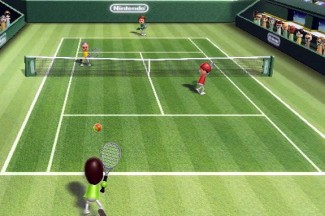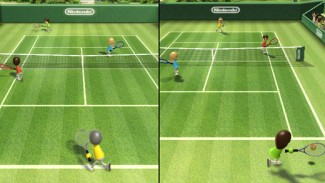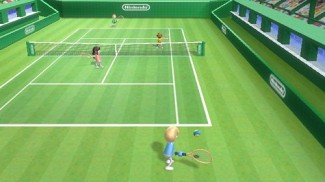Ghostwire Tokyo
LQ: 9.7
Recommended Age: 12+
Skills Used: Flexibility, Working Memory, Reading

In this game, players mimic swinging a tennis racket using the Wii Remote. Players can serve the ball, adjust the power of their shot and perform backhand and forehand swings. They can add spin to the ball by twisting the Wii Remote as they swing and even perform a volley shot, sending the ball high into the air. Matches consist of 1 on 1 games or doubles, with up to four people playing at a time. Due to the simple controls and inoffensive content, the game is recommended for players ages 6 and up.
Managing our actions, feelings and behaviors.
To perform different shots in this game, players must issue a variety of distinct motion commands to control the direction and power of each shot. They can perform backhand or forehand swings, lob the ball into the air, and even spin the ball by twisting the controller. However, if they become flustered or swing wildly, they may end up hitting the ball too hard or sending it in the wrong direction. Mastering the controls takes time, so players should remain calm and avoid becoming frustrated while learning these techniques.
Adapting and adjusting to changing conditions and expectations.
 If players become too predictable during a match, their opponents—both human and computer—will quickly learn their patterns of behavior and be better able to return shots and score points. To throw them off, players should use a variety of shots, switching sides of the course and mixing in quick, up-close forehands with long, lobbing volleys. The gameplay here can get rather fast-paced, so players who aren't able to react quickly may have trouble keeping their opponents on their toes to keep them from scoring points.
If players become too predictable during a match, their opponents—both human and computer—will quickly learn their patterns of behavior and be better able to return shots and score points. To throw them off, players should use a variety of shots, switching sides of the course and mixing in quick, up-close forehands with long, lobbing volleys. The gameplay here can get rather fast-paced, so players who aren't able to react quickly may have trouble keeping their opponents on their toes to keep them from scoring points.
Use this Play Together guide to learn how you can help your child turn Wii Sports: Tennis play time into a positive learning and relationship-building experience. To learn more about why playing games with your children is so important, check out our Science of Play page!
Take a minute to talk with your child about how the Self-Control and Flexibility thinking skills work, and why they are important for success in school and at home.
 Wii Sports: Tennis includes several multiplayer modes for you to enjoy with your child. You can go head-to-head in a singles or double match, play together against the computer, or try to complete challenges in the game's Training Mode. After looking over the gameplay goals listed below, see if you can team up with your child and complete each of the objectives.
Wii Sports: Tennis includes several multiplayer modes for you to enjoy with your child. You can go head-to-head in a singles or double match, play together against the computer, or try to complete challenges in the game's Training Mode. After looking over the gameplay goals listed below, see if you can team up with your child and complete each of the objectives.
Gameplay Goals:
After you’ve completed a few matches, take a minute to pause the game and talk with your child about how Wii Sports: Tennis is exercising your thinking skills.
Our Make it Work activities are designed to transform your child’s gameplay into real-world improvements in thinking and academic skills. If you’re just getting started with LearningWorks for Kids, we suggest you try them all to find which are the best for you and your child.
Read over the pages for Self-Control and Flexibility. Then take some time to introduce these thinking skills to your child.
Explain That:
 It helps impulsive children to use problem-solving strategies in which they always consider more than one possible plan before starting a task. This will serve to delay actions. For example, when your child is doing basic mathematics, teach her to always ask herself what type of operation (addition, subtraction, multiplication, or division) is used before choosing what to do. Initially have your child verbalize (out loud) these types of problem-solving strategies. “What is the problem?” “What are some alternatives?” “What is one other possible answer?” As she masters this approach, encourage silent self-instructions; but as a reminder ask her to tell you about her self-strategies as well.
It helps impulsive children to use problem-solving strategies in which they always consider more than one possible plan before starting a task. This will serve to delay actions. For example, when your child is doing basic mathematics, teach her to always ask herself what type of operation (addition, subtraction, multiplication, or division) is used before choosing what to do. Initially have your child verbalize (out loud) these types of problem-solving strategies. “What is the problem?” “What are some alternatives?” “What is one other possible answer?” As she masters this approach, encourage silent self-instructions; but as a reminder ask her to tell you about her self-strategies as well.
Try teaching your child how to use common household items in different and unusual ways. Ask your child to come up with ten ways to use a fork, book, pen, or piece of clothing and discuss how being flexible can help to solve problems. Flexible problem solving often uses the materials on hand and in the house to fill a variety of different purposes. Talk to your child about ways to apply this approach in his own life.
 Active games like Wii Sports: Tennis can be put to good use for children with ADHD, as studies show that physical exertion can positively effect brain chemistry to help boost key cognitive skills and executive functions. Physical exercise can be an important tool for improving learning and attention, as it results in the production of BDNF (brain-derived neurotrophic factors), proteins in the brain that can help enhance memory and focus. Children with ADHD may have difficulty sticking to an exercise regimen, so engaging games like this can be great tools for working physical activity into a daily routine.
Active games like Wii Sports: Tennis can be put to good use for children with ADHD, as studies show that physical exertion can positively effect brain chemistry to help boost key cognitive skills and executive functions. Physical exercise can be an important tool for improving learning and attention, as it results in the production of BDNF (brain-derived neurotrophic factors), proteins in the brain that can help enhance memory and focus. Children with ADHD may have difficulty sticking to an exercise regimen, so engaging games like this can be great tools for working physical activity into a daily routine.
All membership plans come with full access to our entire suite of tools learning guides, and resources. Here are a few of the ones we think you’ll like the most: